
Poplar is a district in East London, England, now part of the London Borough of Tower Hamlets. Five miles (8 km) east of Charing Cross, it is part of the East End.

Poplar was a local government district in the metropolitan area of London, England. It was formed as a district of the Metropolis in 1855 and became a metropolitan borough in the County of London in 1900. It comprised Poplar, Millwall, Bromley-by-Bow and Bow as well as Old Ford, Fish Island and Cubitt Town.

The Lansbury Estate is a large, historic council housing estate in Poplar and Bromley-by-Bow in the London Borough of Tower Hamlets. It is named after George Lansbury, a Poplar councillor and Labour Party MP.

Pigott Street is a road in Poplar, Tower Hamlets, London. The blocks of flats on it form part of the last phase of the building of the Lansbury Estate, and border the southern end of Burdett Road on the west.
The year 1954 in architecture involved some significant events.
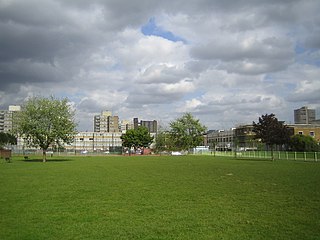
Bartlett Park is a public open space in Poplar in the London Borough of Tower Hamlets in London on Upper North Street. It is located to the south of the Limehouse Cut waterway and the Lansbury Estate to the south and east of the park. The whole landscape is 4.95 hectares.

The Samuda Estate is on the east side of Manchester Road, in Cubitt Town on the Isle of Dogs. With 505 dwellings it is home to about 1,500 people and covers 11.4 acres (4.6 ha).

Poplar and Limehouse is a constituency created in 2010 and represented in the House of Commons of the UK Parliament since 2019 by Apsana Begum of the Labour Party. From its creation until 2019, it was represented by Jim Fitzpatrick, also of Labour.

South Ascot is a village just south of and down the hill from the small town of Ascot in the English county of Berkshire. It is bounded on the west by the Kingsride area of Swinley Woods, on the north by the Reading to Waterloo railway line and merges with Sunninghill to the east.
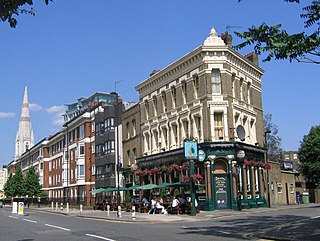
Hercules Road runs north from Lambeth Road near Lambeth Palace, on the site of Penlington Place, in the London Borough of Lambeth, south London, England.
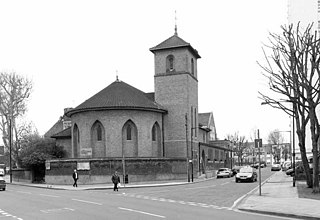
Devons Road is a road in Bow Common and Bromley-by-Bow in east London. Part of the B140 road, it gives its name to the Devons Road DLR station.
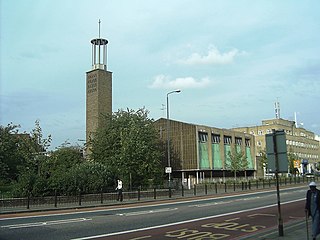
The Trinity Independent Chapel was an early Victorian church in Poplar. It was destroyed by a V-2 rocket hit during the Second World War, and later re-built in Modernist style. In the late 1990s the building was sold to the Calvary Charismatic Baptist Church, and since then has served as their Prayer Temple and international headquarters.
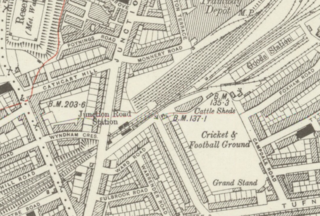
Junction Road railway station was a railway station in London (1872-1943). The station was opened by the Tottenham & Hampstead Junction Railway.

Coventry Cross Estate is a social housing estate in Bromley by Bow area of London.

Chingford Mount Cemetery is a cemetery in Chingford Mount, in the London Borough of Waltham Forest.

The Poplar Rates Rebellion Mural is a mural in Hale Street, Poplar, London, London. It is painted on the wall of the depot of Tower Hamlets Parks Department.
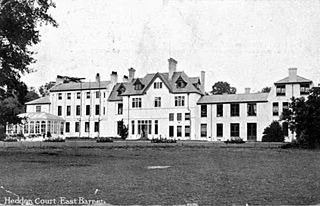
Belmont, originally known as Mount Pleasant, was a house in East Barnet, London, near Cockfosters, that dated back to the sixteenth century. By the end of the nineteenth century it had become Heddon Court and was the home of a preparatory school for boys. The school closed in 1933 and the house was demolished. The site is now occupied by suburban housing.

The Brandon Estate is a social housing estate in Walworth, London Borough of Southwark, south London. Situated to the south of Kennington Park, it was built in 1958 by the London County Council, to designs by Edward Hollamby and Roger Westman.
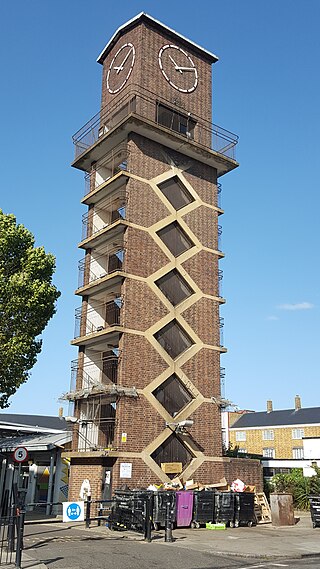
Chrisp Street Market Clock Tower is a Grade II listed landmark located in Market Square, Chrisp Street, Poplar. It was designed by the architect Frederick Gibberd as part of the Lansbury Estate for the Festival of Britain, 1951. The clock tower is an example of early post-war architecture, and an aesthetic that became known as the "Festival Style".


















